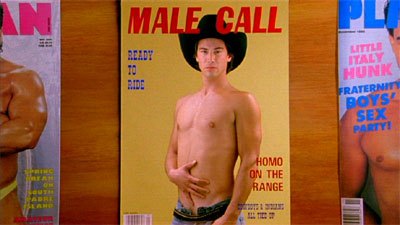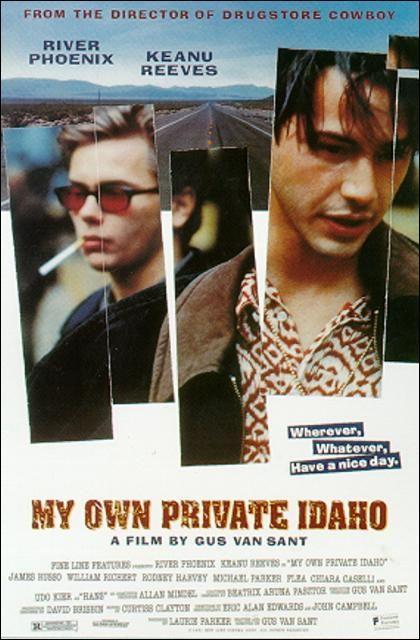Dir. Gus Van Sant
Starring: River Phoenix , Keanu Reeves, James Russo, William
Richert
Twice during Gus van Sant’s My Own Private Idaho the same image
appears: salmon swimming upstream. Consider that image. These salmon are born
in the headwaters of rivers, before swimming down to the sea. They voyage many
thousands of miles before, finally, miraculously, finding their way back to the
very spot where they were born. There, their life’s journey completed, they
die.
I’m sure there’s meant to be some
meaning to that image, so here goes. The two protagonists of the film are, in
many ways, like those fish. Their stories interweave. First we have Mikey
(River Phoenix), a wandering narcoleptic (he is prone to falling asleep suddenly
and without warning). He says that he has “been
tasting roads my whole life”. He wakes in Idaho , sure that he has seen this same
stretch of road before. His thoughts turn towards his mother. He falls
unconscious yet again. When he wakes he is in Seattle , being sucked off by a john. Because
he is a rent boy. He travels from Seattle to Portland in the company
of fellow hustler Scott (Keanu Reeves) before his thoughts turn once more to
his mother and he sets out on a bit of a bildungsroman
to find her. His quest takes him back to the place of his birth, to Idaho , to his brother / father / whatever Richard (James
Russo), then to a hotel (the "Family Tree" appropriately enough) where his mother was known to have worked, and then,
incredibly, to Rome .
It turns out that Mike’s mother, like Mike himself, is trying to trace her own
family. At every step of the way he has just missed her. With no more clues to
follow and deserted by Scott he heads back to Portland and sinks back into the gay
subculture. Increasingly manic he lives on the streets. But Idaho pulls him like a lure. He is last seen
on that same stretch of deserted highway, asleep, being loaded into a passing
truck, for who knows what end.
Scott too cannot escape his
birth. Except that he knows who his father is – his father is the Mayor of
Portland. Scott sinks into the excesses of hustling, robbing and having no
fixed abode, encouraged by and in turn encouraging the Fagin-like Bob Pigeon
(William Richert). But he tells Bob that when he turns 21 he will leave that
life behind and return to his inheritance and his family. “My mother and father will be surprised at the incredible change. It
will impress them more when a fuck-up like me turns good than if I had been a
good son all along”. His thinking is that he will gain more respect by being
bad and then repenting than he ever would be being a good boy all along. And so
it transpires. While he joins Mikey on his quest his climactic moment comes in Italy when he
meets the young woman Mike’s mother had been teaching Italian to. Scott falls in
love with Carmella (Chiara Caselli). He leaves with her. When we next see him
he is groomed and suit-clad, Carmella on his arm, taking his place in Portland high society.
Confronted by Bob, Mike and the rest of the gang he turns away from them,
breaking Bob’s heart – literally. But in the cemetery his eyes stray from the
sombre funeral of his own father to the riotous assembly commemorating Bob, and
the viewer gets the impression that he knows where he would rather be…
These two characters and two
stories interweave about the other. The problem is that they come in two very
different styles. Mike’s tale is impressionistic. When he thinks of his mother
or otherwise gets stressed he collapses. In his mind’s eye we see snapshots of
family life and the seemingly limitless plains of Idaho , empty and void, the clouds scudding
overhead. But it is his plot we follow, his need to find his mother that drives
the tale along. By comparison Scott’s tale is forced into literary conventions.
The plot here is, bizarrely, lifted straight from Shakespeare: Henry IV pts I & II to be precise.
Scott is Prince Hal, heir to the King of England / Mayor of Portland. The
debauched “Santa Claus” of Bob Pigeon
is the dissolute Falstaff, squiring the young prince around the murky underworld
of his home city. Even the language and staging is Shakespearean. I have never
seen or read Henry IV so I do not
know how true to the source material the film is. However, the lines sound like
Shakespearean lines with the occasional modern word like “punks” or “zips” thrown
in. Bob declaims in an English accent. “Let
us not call ourselves robbers” he says “but
Diana’s foresters. Gentlemen of the shade. Minions of the Moon. Men of good
government.” And the set pieces – Bob’s arrival, the robbery, Bob’s tall
tales about that robbery, the sheriff’s raid and Scott’s final turning of his
back upon Bob – ring true as Shakespearean plot points. Even the acting is
Shakespearean – the forced jollity and back slapping from the gang reminded me
of school productions, where the unsure cast try too hard to bring in action to
make up for the fact that they’re not exactly sure what the words coming out of
their mouths mean. And then, suddenly, when Scott and Mike are alone once
again, Keanu starts speaking normally. It is a disjoint. It jars.
What is most interesting really
is the characters’ different attitudes to homosexuality. There are as many
different colours of homosexuality as there are gay porn magazines on the
shelves in one of the movie’s most playful scenes. For Scott, it is just a
phase, and anyway, he’s not gay. He argues that “two guys can’t love each other”. He only sleeps with men for cash.
It is only when you do it for free that you start to “grow wings, and become a fairy”. Mind you, as Bob points out, he
doesn’t actually need the cash – he comes from a rich family and will inherit a
fortune when he turns 21 in a week’s time. And in the end he commits to a heterosexual relationship. Mike, however, is gay. Furthermore,
he is in love – he is in love with Scott, as he haltingly tells him around a
campfire one night in Idaho .
Scott rebuffs the attention, but is human enough to give his friend a consoling
embrace. And then there is some real verisimilitude to colour the palette. Many
of the other hustlers seen in the film were real life male prostitutes.
Furthermore, their droll tales of rape and assault were mostly unscripted –
these were true stories coming out from society’s underbelly and getting
expression on film. I should point out that not all of the gang were local gay
hustlers however – one of them is played by Flea from the Red Hot Chili Peppers!
 |
| I'm not gay, I'm just drawn that way... Scott (Keanu Reeves) models the Brokeback look |
What have I learnt about Idaho ?
Despite the fact that so little
of the film actually takes place in Idaho ,
it is those scenes that do that live longest in the memory. We see Idaho as an empty land
for travelling through and out of. Another parable for life, if you will. The image
of the long, undulating road stretching on straight, seemingly for eternity,
through the barren scrub is a metaphor and a half. The occasional deadbeat
shack or wind-whipped tree may break the monotony momentarily; more expressive
are the low clouds boiling overhead. Sound effects only seem to come from out
of sight – the screech of a hawk or Native American drumming. And as we are
warned by sign, tourists should not laugh at the natives…
Can we go there?
As I say above, there is not that
much of the film that is set in Idaho .
Action is split between Idaho , Seattle (Washington ), Portland (Oregon ) and Rome (Italy ) – a true
cinematic road trip around the Pacific North-West. Few
places in Idaho
specify where they are. The road is, obviously, nameless, though presumably
lies in or near a Native American reservation not far from the Oregon /
Washington border – the Nez Perce Indian Reservation on the road east from Lewiston,
or the Coeur D’Alene Reservation, south of Coeur D’Alene could be contenders.
We are given no indication as to where Richard’s caravan is located other than
that it is near a railway track. The Family Tree Hotel where Mike’s mother
works is on the Snake River, but this river forms two-thirds of the western
border with Oregon and then stretches the
entire breadth of the state and into Wyoming .
In fact, the only Idaho location I can
confidently pinpoint is Boise Airport , from where the two leads fly out to Rome .
And there’s probably a reason why
I can’t work out where in Idaho
My Own Private Idaho was filmed. It
wasn’t. The campfire scene was shot on a sound stage. And the grand haunting
image of endless Idaho road does not come from
Idaho . It
comes from Oregon .
It is a stretch of Route 216 near Maupin, heading towards Grass Valley
The Oregon
scenes were filmed in Oregon
however. Portland is Portland . We first see the city when Mike and
Scott arrive there; they sit beneath the ‘Thompson Elk’ fountain near City
Hall. They then vanish into the demi-monde of what was at one time known as ‘Vaseline
Alley’. The abandoned hotel where Bob’s gang stay is the historic Governor Hotel, then being renovated, and the robbery takes place beneath the St
John’s Bridge in Cathedral Park. The restaurant where the hustlers congregate
is now Bailey’s Taproom,
located on the corner of SW Broadway and Ankeny .
The Seattle
scenes are likewise shot around Seattle
(check out the views down to the harbour when Mike first meets Hans). In Rome Mike wakes up in the
Piazza del Popolo.
So if you want to visit the locations where My Own Private Idaho was filmed, you had better book a ticket to Oregon rather than Idaho.
Overall Rating: 2/5

No comments:
Post a Comment